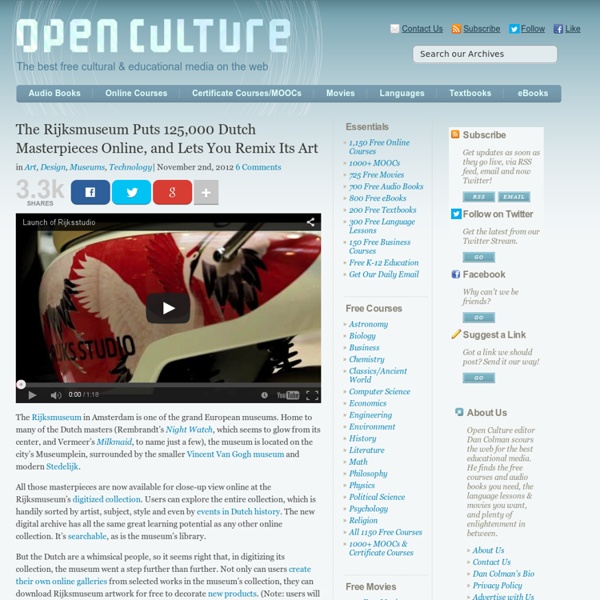The Rijksmuseum Puts 125,000 Dutch Masterpieces Online, and Lets You Remix Its Art

The National Gallery Makes 25,000 Images of Artwork Freely Available Online
No surprise that in “Masterworks for One and All,” an article about how museums have begun to offer free, high-quality downloadable images of works from their collections, the New York Times’ Nina Siegal brings up Walter Benjamin. The preoccupations of the philosopher behind “The Work of Art in the Age of Mechanical Reproduction” may seem more relevant than ever in these days of not just mechanical reproduction, but universal, developed-world ownership of the means of mechanical reproduction — and nearly instantaneous, effortless mechanical reproduction at that. Many rights-holders, including certain museums, have effectively decided that if you can’t beat the mechanical reproducers, join ’em. “With the Internet, it’s so difficult to control your copyright or use of images,” Siegal quotes the Rijksmuseum’s director of collections as saying. Related Content: Google Launches a New “Art Talks” Series: Tune in Tonight Download Hundreds of Free Art Catalogs from The Metropolitan Museum of Art
LA County Museum Makes 20,000 Artistic Images Available for Free Download
The Los Angeles County Museum of Art houses the largest American collection of art west of Chicago. Developed as an “encyclopedic” museum—its collections represent nearly every human civilization since recorded time—LACMA’s eclectic holdings span from art of the ancient world to video installations. Like all great public collections, LACMA sees its mission as providing the greatest possible access to the widest range of art. Two years ago LACMA made a relatively small number of its image holdings available for free download in an online library. This represents about a quarter of all the art represented on LACMA’s site. LACMA’s online collection (80,000 images altogether, including restricted use and unrestricted) is sorted by the usual curatorial terms (“American Art,” “Art of the Pacific” and so on) but that’s just one of many filtering options. But the collection can be searched more narrowly by object type and curatorial area. Related Content: Discover Ansel Adams’ 226 Photos of U.S.
The Getty Puts 4600 Art Images Into the Public Domain (and There's More to Come)
Not long ago, I went over to the Getty to see the J. Paul Getty Trust’s President and CEO James Cuno in live conversation with Pico Iyer, one of his favorite writers as well as one of mine. Cuno, himself the author of books like Whose Culture? “Why open content? Related Content: 40,000 Artworks from 250 Museums, Now Viewable for Free at the Redesigned Google Art Project LA County Museum Makes 20,000 Artistic Images Available for Free Download The Rijksmuseum Puts 125,000 Dutch Masterpieces Online, and Lets You Remix Its Art Art.sy Rolls Out Huge Archive of Fine-Art Images and an Intelligent Art Appreciation Guide Free: The Metropolitan Museum of Art and the Guggenheim Offer 474 Free Art Books Online
New Robert Rauschenberg Digital Collection Lets You Download Free High-Res Images of the Artist’s Work
After the waning of abstract expressionism, Robert Rauschenberg’s exuberant prints, paintings, sculptures, and three-dimensional collages he called “Combines” rejuvenated the New York art world and helped bring pop art to prominence, anticipating Warhol’s experiments. And now students of twentieth-century American art can connect with all of the artist’s work in the San Francisco Museum of Modern Art’s permanent collection without setting foot in the Bay area, thanks to SFMOMA’s Rauschenberg Research Project, which allows users to download high res images of the museum’s Rauschenbergs. Research materials—including commentary, interviews, essays, and more—accompany each image. via Metafilter Related Content: Rauschenberg Erases De Kooning
Related:
Related:



